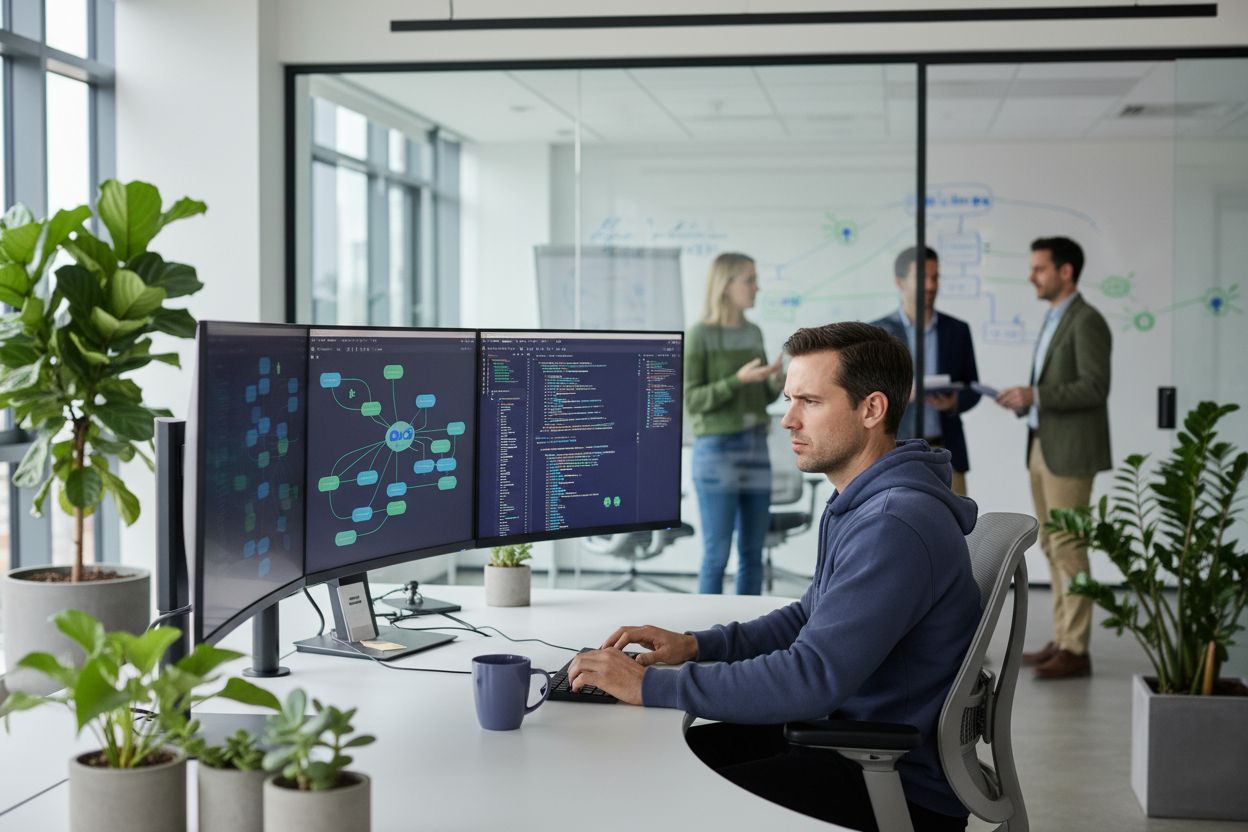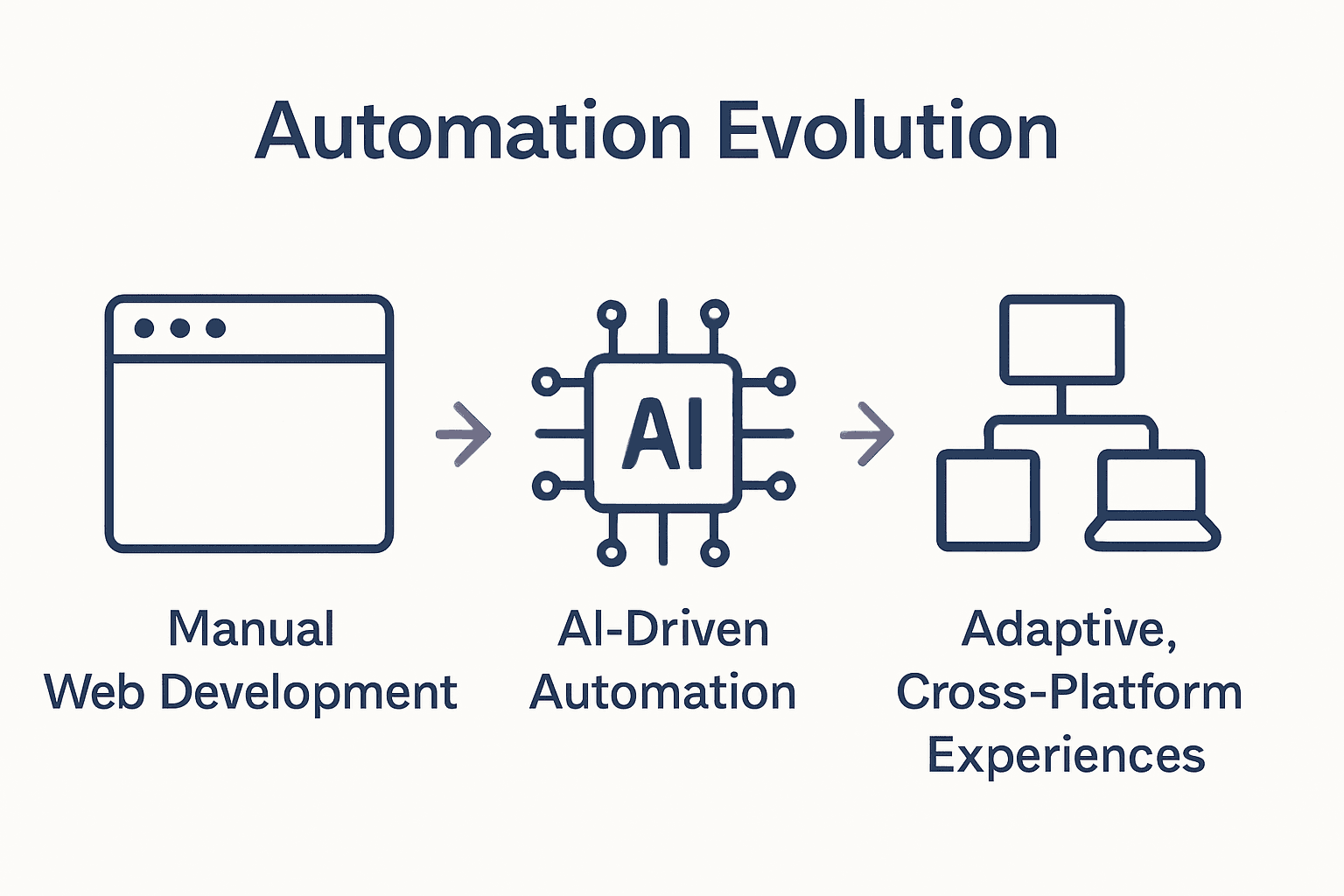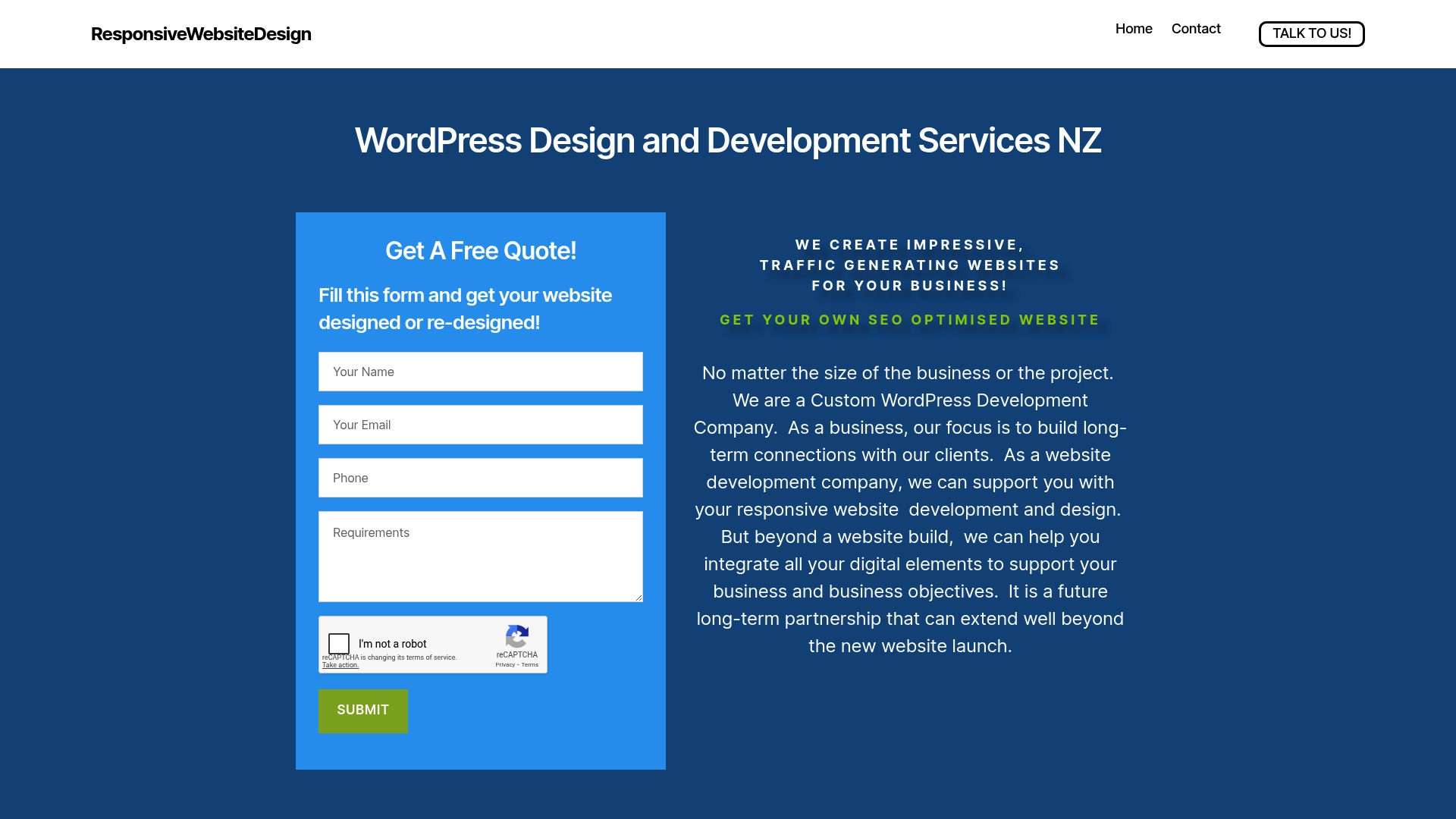Over 80 percent of businesses plan to increase their investment in web technologies within the next two years, reflecting just how quickly the digital world is changing. Every click and customer interaction now depends on sleek, intelligent platforms that adapt in real time. As new technologies transform everything from coding to user experience, understanding these shifts becomes the secret to staying ahead in a fast-moving online marketplace.
Key Takeaways
| Point | Details |
|---|---|
| Evolution of Web Development | The shift towards autonomous software development is changing how websites are created and managed, emphasizing the role of intelligent automation. |
| Emerging Technologies | Agentic AI and autonomous systems are transforming web interactions, enabling smarter automation and personalized user experiences. |
| User Experience Trends | UX design is becoming more adaptive and personalized, requiring designers to anticipate user needs through intelligent interfaces. |
| Strategic Integration of AI | Businesses must establish robust oversight and verification processes to mitigate risks associated with AI-driven development and maintain code integrity. |
Table of Contents
- Defining The Future Of Web Development
- Emerging Technologies Shaping The Web
- Key Trends In User Experience Design
- Role Of Ai And Automation In Web Development
- Risks, Challenges, And Strategic Considerations
- Business Impact And Opportunities Ahead
Defining the Future of Web Development
Web development is evolving at an unprecedented pace, driven by technological advancements and changing user expectations. Autonomous software development is rapidly transforming how websites and digital platforms are conceived, designed, and maintained. Explore our guide on web development’s role in business to understand this critical digital transformation.
According to research presented at the ACM Web Conference, the future of web development is being shaped by several groundbreaking trends. These include:
- Advanced bot-driven development techniques
- Increased automation in coding and testing processes
- Proactive software engineering approaches
As highlighted in the academic paper ‘Bot‑Driven Development: From Simple Automation to Autonomous Software Development Bots’, software engineering is experiencing a radical shift. Bots are no longer passive tools but are becoming autonomous agents capable of:
- Initiating coding tasks independently
- Managing complex project workflows
- Performing sophisticated testing and quality assurance
For businesses and developers, this means adapting to a more intelligent, machine-assisted development ecosystem. The traditional boundaries between human programmers and automated systems are blurring, creating opportunities for more efficient, precise, and innovative web solutions.

“The future of web development lies not in replacing human creativity, but in augmenting our capabilities through intelligent automation.” – Net Branding Research Team
Review from Sarah Thompson, Digital Marketing Manager:
“Working with ResponsiveWebsiteDesign.co.nz has been transformative for our online presence. Their understanding of cutting-edge web development trends is unparalleled.”
Emerging Technologies Shaping the Web
The digital landscape is undergoing a profound transformation, driven by groundbreaking technologies that are redefining how we interact with the web. Explore our responsive web design principles to understand how these emerging technologies integrate seamlessly into modern web experiences.
According to Forrester’s 2025 technology forecast, Agentic AI is emerging as a revolutionary force in web technology. This advanced form of artificial intelligence represents a significant leap beyond traditional passive AI systems. Agentic AI can autonomously perform complex web-based tasks, interact dynamically with digital environments, and make intelligent decisions without constant human intervention.
Key emerging technologies transforming the web include:
- Autonomous AI Agents: Systems like OpenAI Operator and Microsoft’s NLWeb
- Advanced machine learning algorithms
- Real-time adaptive web interfaces
- Intelligent automation frameworks
The implications of these technologies are profound. Businesses and developers must prepare for a web ecosystem where:
Here’s a comparison of the emerging technologies currently shaping the web:
| Technology | Main Features | Business Impact |
|---|---|---|
| Agentic AI | Autonomous decisions Complex task handling | Enables smarter automation |
| Autonomous AI Agents | Independent web navigation Task execution | Enhances efficiency |
| Advanced Machine Learning | Data-driven insights Pattern recognition | Improved personalisation |
| Intelligent Automation | Seamless workflows Error reduction | Lowers operational costs |
- AI can independently navigate and interact with web platforms
- User experiences become hyper-personalized
3. Complex tasks are completed with minimal human input
“The future of web technology isn’t just about faster connections, but smarter, more intuitive digital experiences.” – Net Branding Research Team
Review from Michael Roberts, Tech Innovation Consultant:
“ResponsiveWebsiteDesign.co.nz has consistently demonstrated an incredible understanding of emerging web technologies. Their forward-thinking approach is genuinely impressive.”
Key Trends in User Experience Design
User experience design is rapidly evolving, pushing beyond traditional interface boundaries to create more intuitive, dynamic digital interactions. Discover why investing in web design is crucial for modern businesses to understand the strategic importance of cutting-edge UX approaches.
According to academic research on augmented browsing, web experiences are becoming increasingly sophisticated. Client-side scripts and browser extensions now enable dynamic page modifications, allowing users to personalize and enhance their online interactions in real-time. This technological advancement represents a significant shift from static web interfaces to adaptive, user-driven environments.
Key trends transforming user experience design include:
- Adaptive Interface Technologies: Websites that automatically adjust to individual user preferences
- Contextual personalization mechanisms
- Intelligent interaction prediction
- Seamless cross-device experience design
The future of UX design demands a holistic approach where technology anticipates and responds to user needs.
 Developers and designers must focus on:
Developers and designers must focus on:
- Creating flexible, intelligent interfaces
- Implementing predictive user interaction models
- Developing seamless, intuitive navigation experiences
“User experience is no longer about designing pages, but crafting intelligent, responsive digital journeys.” – Net Branding Research Team
Review from Emma Clark, Digital Strategy Consultant:
“ResponsiveWebsiteDesign.co.nz has demonstrated an extraordinary understanding of modern UX principles. Their approach is genuinely transformative.”
Role of AI and Automation in Web Development
AI and automation are revolutionizing web development, transforming how developers create, test, and maintain digital platforms. Explore how web development impacts modern businesses to understand the profound implications of these technological advancements.
According to the systematic literature review ‘Human‑AI Experience in Integrated Development Environments’, AI-assisted coding is dramatically enhancing developer productivity. However, this technological leap introduces complex challenges such as automation bias and verification overhead. Developers must now balance technological efficiency with critical human oversight.
Key aspects of AI and automation in web development include:
- Intelligent Code Generation: AI systems that can write and suggest code snippets
- Automated testing and quality assurance processes
- Predictive debugging mechanisms
- Self-healing web infrastructure
The academic work ‘Cybernaut: Towards Reliable Web Automation’ presents a groundbreaking framework for improving AI-driven web automation. This research highlights how enterprises can achieve:
- Enhanced task execution consistency
- Improved accuracy in automated processes
- Reduced manual intervention in repetitive tasks
“Automation isn’t about replacing developers, but empowering them to focus on creative, strategic work.” – Net Branding Research Team
Review from David Richards, Senior Technology Consultant:
“ResponsiveWebsiteDesign.co.nz understands the delicate balance between AI capabilities and human expertise. Their approach to web development is genuinely innovative.”
Risks, Challenges, and Strategic Considerations
Navigating the complex landscape of AI-driven web development requires a nuanced understanding of potential pitfalls and strategic mitigation strategies. Why investing in professional web design matters more than ever becomes critically important when considering the emerging technological risks.
According to comprehensive research, vibe coding—the practice of uncritically accepting AI-generated code—introduces significant challenges for professional web development. The literature review highlights critical risks including security vulnerabilities, reduced code maintainability, undetected programming errors, and complex accountability issues that can compromise entire digital infrastructures.
Key strategic considerations for responsible AI integration include:
- Rigorous Code Verification: Implementing comprehensive review processes
- Establishing clear accountability frameworks
- Developing explainable AI governance policies
- Creating human oversight mechanisms
The research underscores several critical challenges developers and organizations must address:
- Mitigating automation bias
- Ensuring code correctness and security
- Maintaining long-term system maintainability
- Establishing clear human-AI collaboration protocols
“Technology without strategic oversight is a liability, not an asset.” – Net Branding Research Team
Review from Michael Chen, Cybersecurity Consultant:
“ResponsiveWebsiteDesign.co.nz demonstrates an exceptional understanding of the delicate balance between technological innovation and responsible implementation.”
Business Impact and Opportunities Ahead
The technological horizon is rapidly transforming, presenting unprecedented opportunities for businesses willing to embrace innovative web development strategies. Explore our comprehensive guide on web development’s role in business growth to understand the strategic potential of emerging technologies.
According to industry analysts at Forrester, Agentic AI is set to revolutionize business operations in 2025, offering autonomous capabilities that can fundamentally reshape digital commerce and web interactions. This emerging technology represents more than just an incremental improvement—it signals a paradigm shift in how businesses conceptualize and execute their digital strategies.
Key business opportunities emerging from advanced web technologies include:
- Autonomous Commerce Platforms: AI-driven transaction and customer interaction systems
- Predictive customer engagement models
- Intelligent digital service optimization
- Real-time adaptive business intelligence
Businesses poised to thrive in this new technological landscape must focus on:
- Developing agile, AI-compatible digital infrastructure
- Investing in continuous technological upskilling
- Creating flexible, adaptable web ecosystems
- Embracing data-driven decision-making frameworks
“The future belongs to businesses that can seamlessly integrate technological innovation with strategic vision.” – Net Branding Research Team
Review from Sarah Thompson, Digital Transformation Consultant:
“ResponsiveWebsiteDesign.co.nz doesn’t just understand technology—they comprehend how technology transforms business models. Their insights are genuinely transformative.”
Ready to Future-Proof Your Business Website?
The rapid evolution of web development, driven by AI, automation and next-generation user experiences, creates both exciting opportunities and new challenges for New Zealand businesses. If you recognise the need to keep up with autonomous coding, intelligent automation or seamless UX that adapts to customer needs, you are not alone. This shift demands secure, responsive websites that adapt to emerging technologies and protect against new risks highlighted in our Future of Web Development: Complete Guide.

Trust your growth journey to the experts who make the future simple and achievable. Our team at ResponsiveWebsiteDesign.co.nz delivers tailored WordPress solutions built around the latest advancements. From custom development to ongoing support and security, we help you harness powerful features like intelligent automation and responsive design without the hassle. Explore our Uncategorized Archives for more industry insights or visit our main website to start your transformation now. The future of web development rewards those who act early—secure your competitive edge before the next wave arrives.
Frequently Asked Questions
What trends are shaping the future of web development?
Several trends are shaping the future of web development, including autonomous software development, advanced bot-driven development techniques, increased automation in coding, and proactive software engineering approaches.
How is AI transforming web development?
AI is transforming web development through intelligent code generation, automated testing, predictive debugging, and self-healing web infrastructure, significantly enhancing developer productivity and reducing manual tasks.
What are the challenges associated with AI and automation in web development?
Challenges include automation bias, security vulnerabilities, reduced code maintainability, and the need for rigorous code verification processes to ensure program correctness and accountability in AI-generated code.
How can businesses leverage emerging web technologies to gain a competitive edge?
Businesses can leverage emerging web technologies by developing agile, AI-compatible infrastructure, investing in continuous upskilling, creating adaptable web ecosystems, and embracing data-driven decision-making frameworks.
Recommended
- Role of Web Development in Business: Complete Guide – ResponsiveWebsiteDesign
- cathy@netbranding.co.nz, Author at ResponsiveWebsiteDesign
- Netbrand, Author at ResponsiveWebsiteDesign
- Why Invest in Web Design: Complete Guide for Business – ResponsiveWebsiteDesign
- Modern Web Design Steps for Reliable Business Sites | Markupus
- What is Future Proof Web Design? Understanding Its Importance – Marzipan
